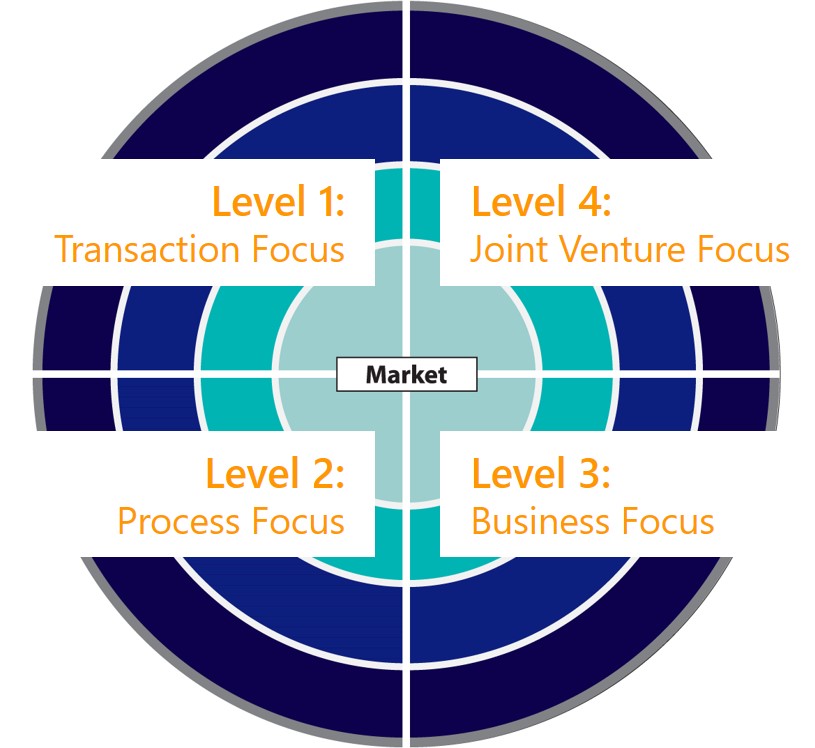
Every wise business person wants to gain a competitive advantage in the marketplace. How can we set ourselves apart? By having a very smart, clear, well executed and fully aligned Go-to-Market Strategy!
A Go-to-Market Strategy is a purposeful and defined strategy to serve customers and win market share by outperforming the competition. It connects the business strategy to the targeted business markets. It defines the type of customer relationships desired to ensure optimum revenue success and competitive advantage.
A thorough analysis of your products/services, your markets, your customers and your competitors should lead you to conclude which of the following strategies would yield the most competitive advantage for your business development.
Revenue Storm has boiled down the various approaches into four, distinct types of Go-to-Market Strategies.

Level One: Transaction Focus
The typical sales cycle of a transactional strategy is simple and fast. It usually consists of 1 to 4 calls per opportunity with 1 to 3 contacts within the customer’s environment. This type of seller is usually calling on operational personnel up to mid-level management titles (contacts) in the client’s company and has numerous accounts in an assigned territory.
The buying experience is quick, convenient, simplified and often the least expensive. It usually takes place with a primary buyer and relatively short sales cycles.
The relationships developed are with a minimal number of people who are usually lower in an organization, unless the volumes are quite large. There is great appreciation for the efficiency of the buying process. It focuses on the ease of buying.
Level Two: Process Focus
The typical sales cycle in a Process focused strategy is more complex than Transactional. The sales process can last multiple weeks to a couple of months with multiple contacts, usually mid-level to senior management titles in client organizations, with occasional executive connections. This type of seller usually has multiple assigned clients in a geographical or vertical market segment.
The buying experience is one-stop shopping for a more complete and integrated solution that crosses over operational departments for a broader solution application.
They need relationships with multiple people, in different departments, who all have the feeling that the seller understands the bigger operational picture.
Level Three: Business Focus
The nature of the Business Focus sales cycle is complex and sophisticated. Longer sales cycles with multiple customer contacts at multiple levels over many months including a heavy executive focus. The sellers have a few, or even one, targeted high-priority accounts typically in a selected vertical. The seller may have a national or global responsibility in the account.
The buying experience includes having a business impact discussion about not just reducing expenses but about how to boost revenues, market share or gain a competitive advantage in the marketplace. It is focused on improving the business, whether a specific revenue stream, business segment or overall.
The resulting relationship is a trusted confidant that serves as a business advisor and provides feelings of security, which results in buying confidence derived from the compelling value proposition.
Level Four: Joint Ventures
A Joint Venture sales cycle is unique and is only done by a very few people in an organization. It is highly sophisticated, focuses on business potential that can be best achieved for both parties only if they partner together. Multiple executive-to-executive contacts between buyer and seller’s organizations will occur before the legal and marketing teams are brought into the discussions. They are complicated contracts with each party building in expectations on the other party.
The buying experience is that of shared risk agreeing to go to market together in new ways to achieve new revenue streams or to takeover market share by their joint force.
The resulting relationship is a mutual partnership around planned indispensability of each other.
Typically, there will be multiple relationships, at multiple levels, within both the customer and seller's organization.
One of these strategies is not better than the others, it depends on which strategy you can best execute and which strategy will give you the most competitive advantage while optimizing your profitability. In some cases, a Level Two Process strategy may be deemed to be better than a Level Three Business strategy. It depends on your unique organization, your industry, and your desired market.
A few quick pointers in finalizing your strategy:
- Each revenue stream in your organization should be anchored in a purposefully chosen Go-to-Market Strategy.
- The Strategy must be aligned to your selection and hiring profile. Who would best execute this type of sale and build these kind of relationships?
- The Strategy determines what kind of sales training your sales team should receive as the successful sales call in each of these Levels will be very different.
- The Strategy must be supported with an aligned recognition and compensation plan to reward the right sales behaviors and desired sales results.

